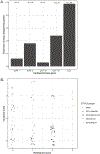Clinical and genomic characterization of Klebsiella pneumoniae infections in Dhaka, Bangladesh
- PMID: 39725322
- PMCID: PMC12067484
- DOI: 10.1016/j.jgar.2024.12.016
Clinical and genomic characterization of Klebsiella pneumoniae infections in Dhaka, Bangladesh
Abstract
Background: Klebsiella pneumoniae (Kpn), a WHO priority pathogen with high rates of antimicrobial resistance (AMR), has emerged as a leading cause of hospital acquired pneumonia and neonatal sepsis.
Objective: We aimed to define the clinical characteristics of a cohort of patients with Kpn infection in Dhaka, Bangladesh and to perform phenotypic and genetic characterization of the associated isolates.
Methods: We retrospectively extracted clinical data about patients at Dhaka Medical College Hospital from whom Klebsiella spp was isolated from a clinical specimen collected between February and September 2022. We used standard microbiologic techniques to evaluate AMR and whole-genome sequencing (WGS) to assess dominant lineages, common capsular (K) and O-polysaccharide (O) antigen types, and AMR and virulence genes.
Results: Ninety-eight patients were included, with diagnoses of pneumonia (38/98, 39 %), wound infection (29/98, 31 %), urinary tract infection (29/98, 31 %) and bacteremia (2/98, 2 %). We tested isolates for susceptibility to eight classes of antibiotics. Of the 98 isolates, 41 % were multidrug resistant (MDR), 15 % were extensively drug resistant (XDR), and 16 % were pan-drug resistant (PDR). Three isolates (3 %) were resistant to polymyxin B. Outcome data were available for 46 patients; 4 patients (8 %) died from infections caused by PDR (n = 2), XDR (n = 1), and MDR isolates (n = 1). WGS revealed a high degree of genomic diversity, with multiple sequence types (STs), O-types and K-types represented; ST16:K81:OL101 and ST43:K30:O1 were the most prevalent.
Conclusion: Our findings suggest alarming levels of AMR among Kpn isolates in Bangladesh and a critical need for improved treatment modalities and vaccine development.
Keywords: Antimicrobial resistance; Bacterial virulence; Klebsiella pneumoniae; Sequence types.
Copyright © 2024 The Authors. Published by Elsevier Ltd.. All rights reserved.
Conflict of interest statement
Declaration of competing interest SET, JBH and RCL have received royalties from UpToDate. All other authors: no reported conflicts of interest.
Figures



References
-
- Wyres KL, Holt KE. Klebsiella pneumoniae as a key trafficker of drug resistance genes from environmental to clinically important bacteria. Curr Opin Microbiol 2018;45:131–9. - PubMed
-
- Pham MH, Hoi LT, Beale MA, Khokhar FA, Hoa NT, Musicha P, et al. Evidence of widespread endemic populations of highly multidrug resistant Klebsiella pneumoniae in hospital settings in Hanoi, Vietnam: a prospective cohort study. Lancet Microbe 2023;4(4):e255–63. - PubMed
MeSH terms
Substances
Grants and funding
LinkOut - more resources
Full Text Sources
Miscellaneous

